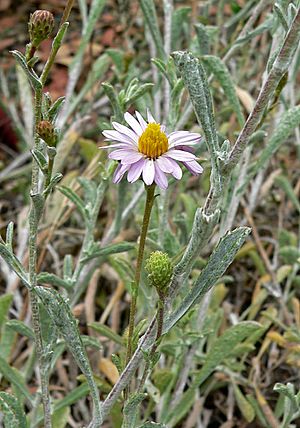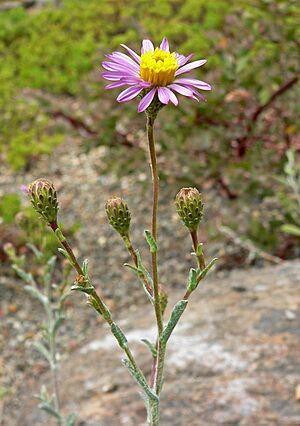Corethrogyne filaginifolia facts for kids
Quick facts for kids Corethrogyne filaginifolia |
|
|---|---|
 |
|
| Scientific classification | |
| Kingdom: | |
| (unranked): | |
| (unranked): | |
| (unranked): | |
| Order: | |
| Family: | |
| Tribe: |
Astereae
|
| Genus: |
Corethrogyne
|
| Species: |
C. filaginifolia
|
| Binomial name | |
| Corethrogyne filaginifolia (Hook. & Arn.) Nutt.
|
|
| Synonyms | |
|
Synonymy
Aster filaginifolius Hook. & Arn.
Aster tomentellus Hook. & Arn. Corethrogyne brevicula Greene Corethrogyne caespitosa Greene Corethrogyne californica DC. Corethrogyne flagellaris Greene Corethrogyne floccosa Greene Corethrogyne incana (Lindl.) Nutt. Corethrogyne lavandulacea Greene Corethrogyne leucophylla (Lindl. ex DC.) Menzies ex Jeps. Corethrogyne linifolia (H.M.Hall) Ferris Corethrogyne obovata Benth. Corethrogyne racemosa Greene Corethrogyne rigida (Benth.) A.Heller</label> Corethrogyne scabra Greene Corethrogyne sessilis Greene Corethrogyne spathulata A.Gray Corethrogyne tomentella (Hook. & Arn.) Torr. & A.Gray Corethrogyne virgata Benth. Corethrogyne viscidula Greene Lessingia filaginifolia (Hook. & Arn.) M.A.Lane |
|
Corethrogyne filaginifolia is a type of flowering plant in the daisy family. It is also known as the common sandaster or California aster.
Scientists who study plants (called taxonomists) sometimes change how they group plants. This plant's name has changed a few times. It was once grouped with plants called Lessingia filaginifolia, but now it's back in the Corethrogyne group as one main species with many older names.
This plant grows naturally in western North America. You can find it from the southwest part of Oregon through California all the way to Baja California. It is a common plant in many different places, like chaparral, forests, scrublands, grasslands, and even in special serpentine soils.
What Does Corethrogyne filaginifolia Look Like?
Corethrogyne filaginifolia is a strong perennial plant. This means it lives for more than two years. It can be a herb (a plant with soft stems) or a small subshrub (a plant with woody stems at the base).
Stems and Leaves
Its stems can be simple or have many branches. They can grow up to about 1 meter (about 3 feet) long or tall. The leaves are covered in thick, soft hairs, making them feel woolly. They are several centimeters long. Leaves lower on the stem often have teeth or lobes, while those higher up are smaller.
Flowers
The flowers grow in a group called an inflorescence. This can be a single flower head or several heads at the ends of the branches. Each flower head has narrow, pointed leaves called phyllaries around the outside. These phyllaries often have purple tips and curl back as the flower head gets older.
Inside the head, you'll find many colorful flowers.
- Ray florets: These are the petal-like flowers on the outside. They can be purple, lavender, pink, or white.
- Disc florets: These are tiny, tube-shaped yellow flowers packed in the center. There can be up to 120 of them!
Fruit
After the flowers bloom, the plant produces a small, dry fruit called an achene. On top of this fruit is a feathery or bristly part called a pappus, which helps the seeds spread.
See also
 In Spanish: Corethrogyne filaginifolia para niños
In Spanish: Corethrogyne filaginifolia para niños


